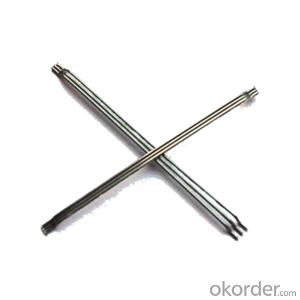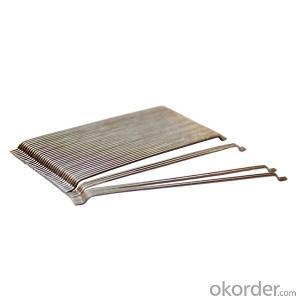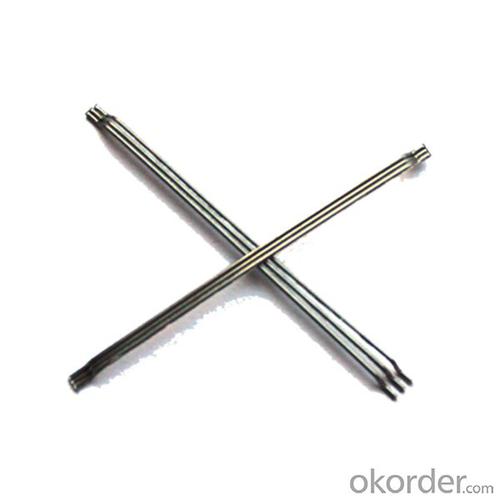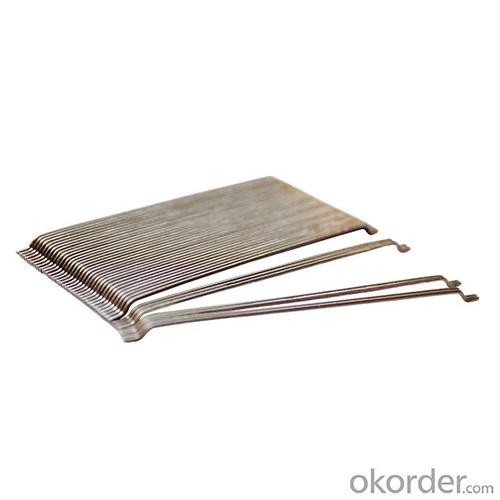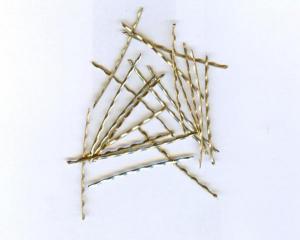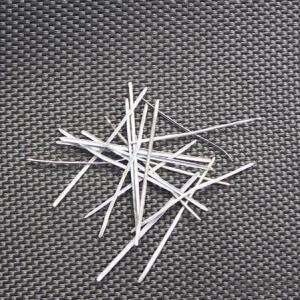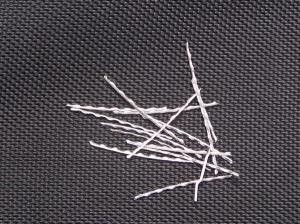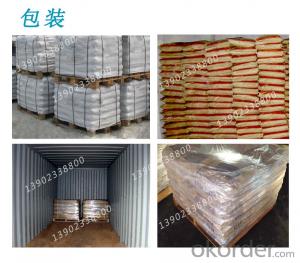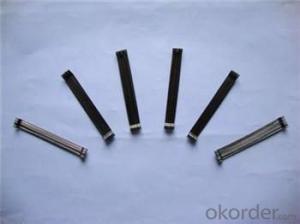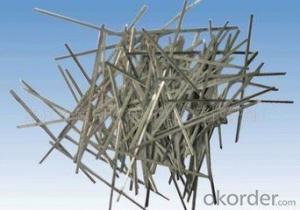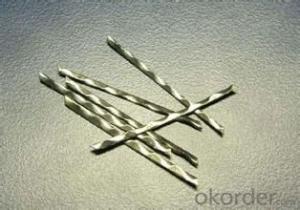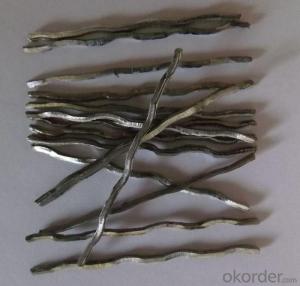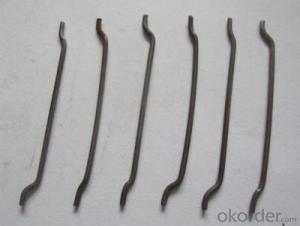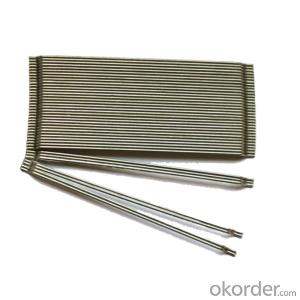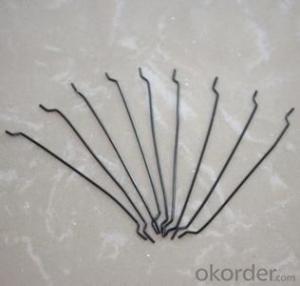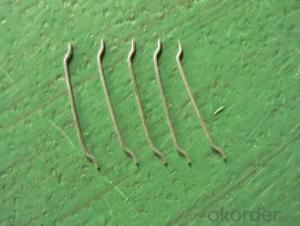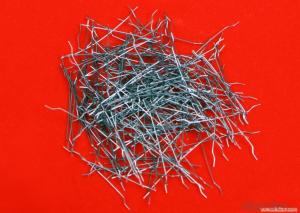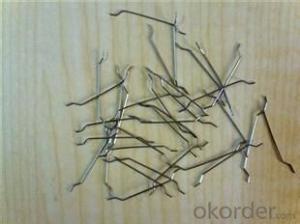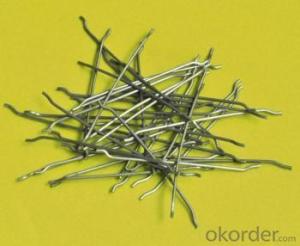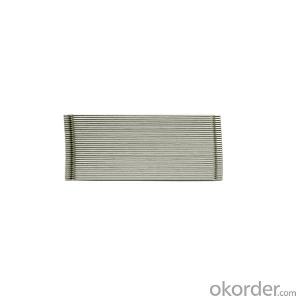Melt Extract Stainless Steel Fiber for Construction Companies UAE High Quality Steel Fiber CNBM
- Loading Port:
- Tianjin
- Payment Terms:
- TT OR LC
- Min Order Qty:
- 1 m.t.
- Supply Capability:
- 600 m.t./month
OKorder Service Pledge
Quality Product, Order Online Tracking, Timely Delivery
OKorder Financial Service
Credit Rating, Credit Services, Credit Purchasing
You Might Also Like
Quick Details
Place of Origin: Tianjin, China (Mainland)
- Model Number: 0.5
Material: Steel
Production Process: Cold drawn
Fiber Lengh: 30
Type: 1
Compressive Strength: >1200MPa
Aspect ratio: 60
Standard: ASTM A820M-11
Section Shape: Circular
Application: Concrete Reinforcement
- Product Application: Industrial Floor
Packaging & Delivery
| Packaging Details: | 20 kg/Bag,50 bags/Pallet or 1,000kg/ Bulk Bag |
|---|---|
| Delivery Detail: | 1 Month |
Product Description
| Diameter | 0.5 mm (0.197 in) | ||
| Length | 30 mm (11.811 in) | ||
| Aspect Ratio | 60 | ||
| Tensile strength | 1200 MPa | ||
| Type | Cold drawn Steel Fiber | ||
| End | Hooked-end Steel Fiber | ||
| Glued/Loose | Glued Steel Fiber | ||
| Bending Angle | 45°(min.30°) | ||
| Usage & Performance | Floor:Trafficked areas and Industrial floors | ||
| Shotcrete :Slope stabilization and Final lining | |||
| Precast concrete:Pipe and Railway sleepers | |||
| Packing | Standard Export Pallet Packing | Bag Packing | 20 kg/Bag,50 bags/Pallet |
| Bulk Packing | 1,000kg/ Bulk Bag | ||
| Loading Quantity | 20’GP | 20-25 Tonne/Tonnes | |
| 40’GP | 25-27 Tonne/Tonnes | ||
| 40’HQ | 25-27 Tonne/Tonnes | ||
| MOQ | 1 kg for trial order | ||
| Supply Ability | 10,000 Tonne/Tonnes per Year | ||
| Payment Terms | T/T or L/C at sight | ||
| Delivery Time | Within 15 days after receiving deposit or original L/C at sight | ||
| Certification | ISO9001:2000, CE, | ||

| Product | Diameter | Length mm/in | Aspect Ratio | Type | Packing |
| G-6030 | 0.5 mm (0.197 in) | 30 mm (11.811 in) | 60 | Glued | 20 kg/Bag, or 1,000kg/ Bulk Bag |
| G-6535 | 0.55 mm (0.217 in) | 35 mm (13.780 in) | 65 | Glued | 20 kg/Bag, or 1,000kg/ Bulk Bag |
| G-6035 | 0.6 mm (0.236 in) | 35 mm (13.780 in) | 60 | Glued | 20 kg/Bag, or 1,000kg/ Bulk Bag |
| G-8060 | 0.75 mm (0.295 in) | 60 mm (23.622 in) | 80 | Glued | 20 kg/Bag, 50 bags/Pallet |
| G-6060 | 0.9 mm (0.354 in) | 60 mm (23.622 in) | 60 | Glued | 20 kg/Bag, 50 bags/Pallet |
| G-6030 | 0.5 mm (0.197 in) | 30 mm (11.811 in) | 60 | Loose | 20 kg/Bag, or 1,000kg/ Bulk Bag |
| G-6535 | 0.55 mm (0.217 in) | 35 mm (13.780 in) | 65 | Loose | 20 kg/Bag, or 1,000kg/ Bulk Bag |
| G-6035 | 0.6 mm (0.236 in) | 35 mm (13.780 in) | 60 | Loose | 20 kg/Bag, or 1,000kg/ Bulk Bag |
| G-8060 | 0.75 mm (0.295 in) | 60 mm (23.622 in) | 80 | Loose | 20 kg/Bag, 50 bags/Pallet |
| G-6060 | 0.9 mm (0.354 in) | 60 mm (23.622 in) | 60 | Loose | 20 kg/Bag, 50 bags/Pallet |
- Q: Can melt extract stainless steel fiber be used in seismic-resistant concrete structures?
- Yes, melt extract stainless steel fiber can be used in seismic-resistant concrete structures. Stainless steel fibers, including melt extract stainless steel fibers, are commonly used as reinforcement in concrete to enhance its tensile strength, ductility, and durability. In seismic-resistant concrete structures, where the concrete is subjected to significant dynamic loads during earthquakes, the inclusion of stainless steel fibers can significantly improve the overall performance and resistance of the structure. The use of melt extract stainless steel fibers in seismic-resistant concrete structures offers several advantages. Firstly, stainless steel fibers have high tensile strength and excellent ductility, which allows them to effectively distribute the applied forces and resist cracking and deformation under seismic loads. This helps to maintain the integrity of the concrete structure and prevent catastrophic failure during earthquakes. Additionally, stainless steel fibers exhibit excellent corrosion resistance, which is crucial in seismic-resistant concrete structures that may be exposed to harsh environmental conditions, such as high moisture or chloride exposure. The corrosion resistance of stainless steel fibers ensures the long-term durability and structural integrity of the concrete, even in aggressive environments. Moreover, melt extract stainless steel fibers also provide enhanced bond strength between the fiber and the concrete matrix. This improves the overall composite behavior of the concrete and enhances its resistance to shear stresses and cracking, which are common during seismic events. Overall, the use of melt extract stainless steel fiber in seismic-resistant concrete structures is a viable and effective solution to enhance their structural performance and durability. It helps to improve the tensile strength, ductility, and corrosion resistance of the concrete, ensuring its ability to withstand the dynamic forces and deformations associated with earthquakes.
- Q: Is melt extract stainless steel fiber compatible with different types of shotcrete curing methods?
- Yes, melt extract stainless steel fiber is compatible with different types of shotcrete curing methods. This type of fiber is often used in shotcrete applications to improve the strength, durability, and ductility of the concrete. It can be added to the shotcrete mix and sprayed onto various surfaces using wet or dry methods. Melt extract stainless steel fiber can be effectively used with different shotcrete curing methods including standard wet curing, accelerated curing, and polymer-based curing. It helps to reduce cracking and shrinkage of the shotcrete, improving its overall performance and longevity. Additionally, melt extract stainless steel fiber is highly resistant to corrosion and can withstand harsh environmental conditions, making it suitable for use in various shotcrete curing methods. It provides excellent bonding with the concrete matrix, enhancing its structural integrity and resistance to impact and abrasion. In summary, melt extract stainless steel fiber is compatible with different types of shotcrete curing methods and can significantly enhance the performance and durability of shotcrete applications.
- Q: What is the effect of melt extract stainless steel fiber on the dimensional stability of concrete?
- The use of melt extract stainless steel fiber in concrete has a significant effect on the dimensional stability of the material. These fibers are added to the concrete mixture during the mixing process, where they are evenly dispersed throughout the mixture. One of the main benefits of melt extract stainless steel fiber is its ability to enhance the overall strength and durability of concrete. The fibers act as reinforcement, providing additional tensile strength to the material. This reinforcement helps to prevent cracking and shrinkage, which are common issues in concrete structures. By reducing cracking and shrinkage, melt extract stainless steel fiber improves the dimensional stability of concrete. This means that the concrete maintains its original shape and size over time, even under varying environmental conditions such as temperature changes or moisture exposure. The addition of these fibers also improves the overall performance of the concrete in terms of resistance to impact, abrasion, and fatigue. This makes it particularly useful in applications where the concrete will be subjected to heavy loads or frequent wear and tear. Furthermore, melt extract stainless steel fiber can also enhance the fire resistance of concrete. The fibers have a high melting point, which helps to slow down the spread of fire and prevent structural collapse. This is especially important in buildings and structures where fire safety is a concern. Overall, the use of melt extract stainless steel fiber in concrete greatly improves its dimensional stability, strength, and durability. This leads to longer-lasting, more reliable concrete structures that are better able to withstand various environmental and mechanical forces.
- Q: Can melt extract stainless steel fiber be used in self-compacting concrete?
- Yes, melt extract stainless steel fiber can be used in self-compacting concrete. Self-compacting concrete (SCC) is a specialized type of concrete that is highly fluid and able to flow and fill complex forms without the need for vibration. It is typically used in applications where traditional concrete pouring methods are not feasible. Adding stainless steel fibers to SCC can provide several benefits, including increased tensile and flexural strength, improved crack resistance, and enhanced durability. The use of stainless steel fibers can also help control shrinkage and reduce the likelihood of plastic shrinkage cracking. Melt extract stainless steel fibers are specifically designed for use in concrete applications. They are produced by melting stainless steel and then rapidly cooling and solidifying it to create thin, elongated fibers. These fibers are typically added to the concrete mixture during the mixing process. The addition of melt extract stainless steel fibers can help enhance the overall performance and structural integrity of self-compacting concrete, making it a suitable choice for various construction projects. However, it is important to consult with a structural engineer or concrete specialist to determine the appropriate fiber dosage and ensure compatibility with the specific SCC mix design.
- Q: How does melt extract stainless steel fiber affect the ductility of shotcrete?
- The ductility of shotcrete is significantly influenced by the inclusion of melt extract stainless steel fiber. Ductility refers to a material's capability to undergo deformation without fracturing or breaking. When melt extract stainless steel fibers are introduced into shotcrete, they enhance the overall ductility of the substance. The addition of stainless steel fibers boosts the tensile strength of shotcrete, rendering it more resistant to cracking when subjected to tensile stress. These fibers act as reinforcement within the shotcrete matrix, offering additional support and improving the substance's ability to withstand external forces. With the inclusion of melt extract stainless steel fibers, shotcrete experiences increased ductility, allowing it to better accommodate any structural movement or settlement. This is especially crucial in situations where shotcrete is exposed to dynamic loading or ground movements, such as in tunnels or underground structures. Moreover, the improved ductility of shotcrete resulting from the integration of stainless steel fibers also enhances its durability. The fibers aid in the distribution and dissipation of applied loads or stresses more evenly throughout the substance, preventing localized cracking or failure. In summary, the integration of melt extract stainless steel fiber into shotcrete has a positive impact on its ductility by enhancing its tensile strength, increasing its resistance to cracking, and improving its ability to withstand external forces. This makes shotcrete more reliable and suitable for various construction applications, providing enhanced structural performance and longevity.
- Q: How does the addition of melt extract stainless steel fiber affect the ductility of concrete?
- The addition of melt extract stainless steel fiber generally improves the ductility of concrete. Stainless steel fibers act as reinforcements within the concrete matrix, enhancing its ability to withstand tensile stresses. This results in a higher ductility, allowing the concrete to undergo more deformation before failure.
- Q: How does the fiber length affect the performance of melt extract stainless steel fiber in concrete?
- The fiber length of melt extract stainless steel fiber in concrete directly influences its performance. Longer fibers provide enhanced reinforcement and improved crack resistance, as they can bridge larger gaps and distribute loads more effectively. Additionally, longer fibers increase the flexural strength and toughness of concrete, making it more durable and resistant to cracking under stress. Therefore, the fiber length plays a significant role in enhancing the overall performance and structural integrity of concrete with melt extract stainless steel fibers.
- Q: Can melt extract stainless steel fiber be used in shotcrete or sprayed concrete?
- Yes, melt extract stainless steel fiber can be used in shotcrete or sprayed concrete. Melt extract stainless steel fiber is a type of reinforcement material that is added to concrete mixtures to enhance their strength and durability. It is particularly useful in shotcrete or sprayed concrete applications where the concrete is sprayed onto a surface, as it improves the bond between the concrete and the substrate. The use of melt extract stainless steel fiber in shotcrete or sprayed concrete can help to prevent cracking and improve the overall structural integrity of the concrete.
- Q: Can melt extract stainless steel fiber be used in lightweight concrete applications?
- Yes, melt extract stainless steel fiber can be used in lightweight concrete applications. The addition of stainless steel fibers enhances the strength and durability of lightweight concrete, making it suitable for a wide range of construction applications.
- Q: Bridge deck pavement 8cm steel fiber micro expansion concrete, which kind of mixer can meet the requirement later?
- Stir (about 2-4 minutes) and then into the cement and water mixing (wet cement can be put in dry mixing), can be adjusted according to the amount of transportation and transportation distance of the steel fiber concrete slump, if it is pumping, the slump can be slightly larger!
Send your message to us
Melt Extract Stainless Steel Fiber for Construction Companies UAE High Quality Steel Fiber CNBM
- Loading Port:
- Tianjin
- Payment Terms:
- TT OR LC
- Min Order Qty:
- 1 m.t.
- Supply Capability:
- 600 m.t./month
OKorder Service Pledge
Quality Product, Order Online Tracking, Timely Delivery
OKorder Financial Service
Credit Rating, Credit Services, Credit Purchasing
Similar products
Hot products
Hot Searches
Related keywords
